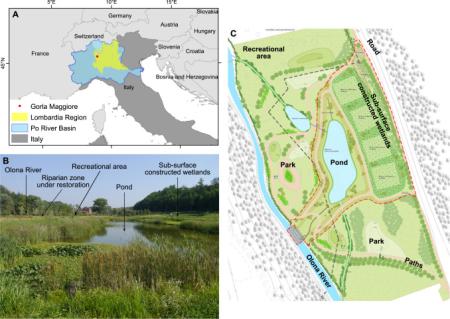
Area characterisation:
The study area is located in Gorla Maggiore, a small municipality in northern Italy. Gorla Maggiore hosts an innovative nature-based solution to treat water pollution from the adjacent urban area. It consists of a green infrastructure that was specifically designed to treat the water discharged into the Olona River by the Combined Sewer Overflow (CSO), i.e. the excess flow of mixed sewage and rainwater that cannot be treated in the waste-water treatment plant during heavy rain events. These overflows are relatively common in the site (70 events were registered between March and August 2014, and contain not only stormwater but also untreated human and industrial waste, toxic materials, and solids.
Objective:
This study assesses the benefits of a multi-purpose nature-based solution for water pollution control in a peri-urban area located in Gorla Maggiore (northern Italy), using an ecosystem service approach and applying an integrated valuation based on MCA for local water management. This solution is compared with the alternative “doing nothing” and with the construction of conventional grey infrastructure. This case study gives an example of integrating different value systems and stakeholders' viewpoints, thus providing hands-on guidance for integrated valuation in ecosystem service assessments linked to (water) decision-making.
Financing:
This research was funded by the EU FP7 project OpenNESS
Potential impacts/benefits:
The results reflect that the green infrastructure performs equal to or even better than the grey infrastructure alternative for water purification and flood protection, it has a similar cost, and it provides additional benefits (like wildlife support and recreation). The most preferred alternative is the green infrastructure, followed by the grey infrastructure and the poplar plantation.
Actions:
No information
Transferability of result:
In this case study, the MCA is used retrospectively, to evaluate an already built infrastructure (ex post evaluation) but the results could also be used prospectively to appraise new proposals of constructed wetlands under similar circumstances. In particular, AHP is a tool that can help decision-makers translate stakeholders' desires and expectations into beneficial public policies or decisions. The findings can be particularly useful for similar situations: small municipalities aiming to treat their CSO as requested, for instance, by the EU Water Framework Directive.
Contacts:
No information
Global goals:
-
6. Clean water and sanitation
-
14. Life below water
NBS goals:
- Restoring ecosystems and their functions
- Multi-functional nature-based watershed management and ecosystem restoration
NBS benefits:
- Restoring ecosystems and their functions
- Improve water quality